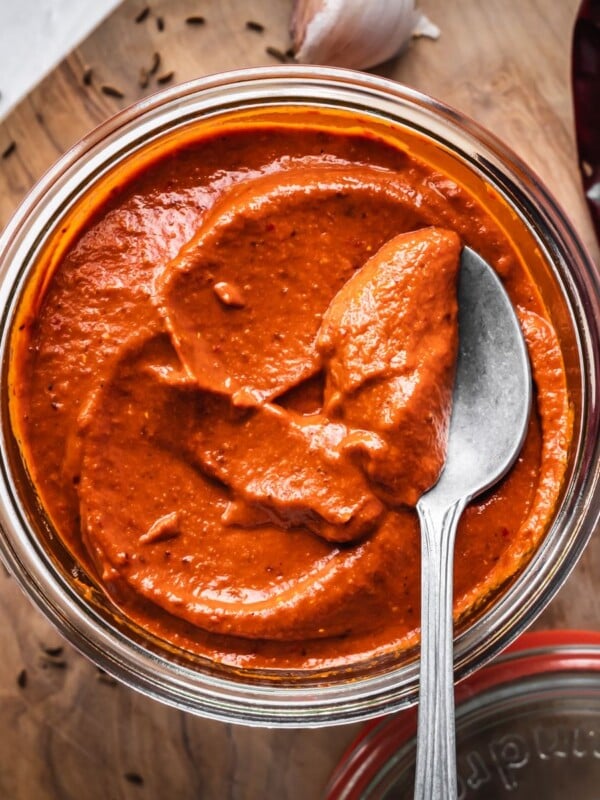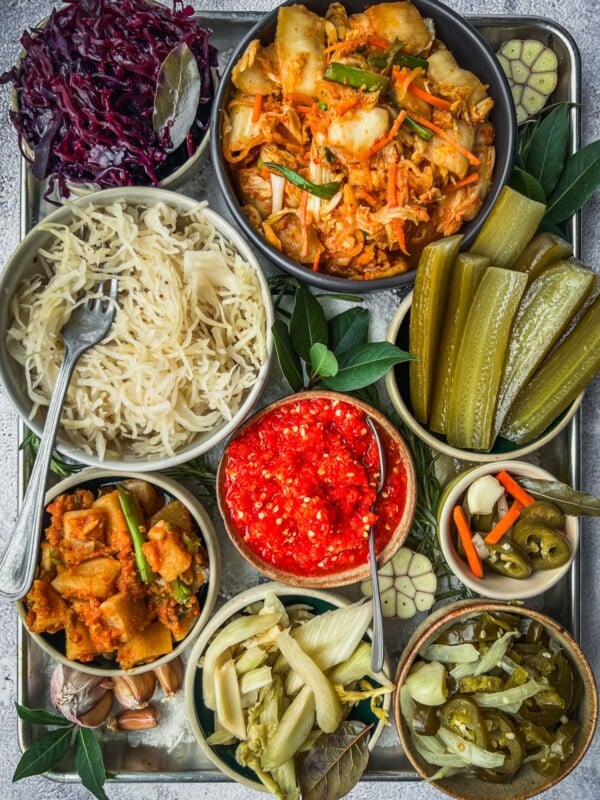Sambal Oelek is a spicy Indonesian chili paste used as a side dish or condiment that can easily be made at home. It’s spicy, sour, salty and can be made slightly sweet. This recipe includes an optional (but recommended) fermentation step to amp up the flavor. Use it to season noodle dishes, curries, and grilled proteins.
This recipe is featured in my 11 Easy and Straightforward Fermentation Recipes post.

Table of Contents
What is Sambal?
Sambal is a spicy condiment or sauce commonly found in Indonesian, Malaysian, Singaporean, and Sri Lankan cuisines, although variations exist throughout Southeast Asia. It serves as a staple accompaniment to many dishes, adding heat, flavor, and complexity to meals.
The word “sambal” itself is derived from the Sundanese language of Western Java, where it refers to a mixture of ground chili peppers with other ingredients. The word “Oelek” which is sometimes spelled “ulek” or “olek” refers to a mortar and pestle.
The exact origins of sambal are not well-documented, but it likely evolved over time as a way to preserve and enhance the flavors of food in a tropical climate.
The primary ingredient in sambal is chili peppers, which were introduced to Southeast Asia by Portuguese traders in the 16th century. Indonesians embraced chili peppers and incorporated them into their cuisine, leading to the development of various sambal recipes.
Sambal recipes vary widely depending on regional preferences and available ingredients. While chili peppers are a common base, other ingredients such as garlic, shallots, shrimp paste, fish sauce, tamarind, lime juice, and vinegar are often included to add depth of flavor.
A Note on Fermentation
Fermentation, or more precisely lacto-fermentation, involves submerging vegetables and fruits in a brine solution (salt and water) or salting them sufficiently to get them to release their own juices. Rather than killing bacteria (like pickling typically does), this process takes a different approach.
The world is full of bad bacteria (e.g., Clostridium botulinum) and good bacteria (e.g., Lactobacillus). When done correctly, fermentation kills or suppresses the bad bacteria while giving the good bacteria a chance to thrive. This process transforms the vegetables and/or fruits into healthy, probiotic-rich lacto-fermented food.

This recipe includes a simple 3-day fermentation step. This step is optional but I think it will yield a much more flavorful and balanced finished product. Plus, it will draw out some of the moisture from the peppers which will concentrate the flavor.
If you are interested in fermented foods, I recommend reading my Lacto-Fermentation article and trying some of my Fermentation Recipes including fermented hot sauce, shatta (Middle Eastern chili paste), Korean Radish Kimchi and fermented jalapeños.
Ingredients
This recipe uses fresh and simple ingredients. I love making this recipe during the summer months when chili peppers are in season and abundant in mu garden.

- Hot peppers: Traditionally you would use Thai bird chilies, but they can be extremely spicy. I like to use a combination of red chilies (fresh cayenne pepper, Thai chilies, even red jalapenos).
- Sweet peppers: Using sweet peppers is not traditional, but we all have our own spice tollerances. I like to use a bit of sweet red bell pepper to offset the heat of the chilies, but feel free to use as much or as little as you like.
- Garlic: Sambal is all about balance, and garlic provides that umami flavor punch. Use as much or as little as you like.
- Shallot: I like adding a small shallot to my sambal, again, it provides another layer of flavor. You can use half a white onion, or red onion or omit the onion entirely.
- Salt: When fermenting, it is important to use kosher salt, pickling salt, or sea salt. Avoid using table salt as it has iodine added to it which can possibly hinder fermentation.
- Acid: When the fermentation step is complete, I like to add a combination of rice vinegar and lime juice to my homemade sambal oelek. This balances the flavor but also helps with preservation. A similar acid profile can be found in my fermented mango hot sauce and passion fruit hot sauce.
See the recipe card for full information on ingredients and quantities.
How to Make this Fermented Sambal Oelek Recipe
This is a straightforward recipe but I recommend you read through all the steps first. The fermentation step is optional but recommended for maximum flavor.

Step 1. Weigh the pepper mix. To a bowl, add your chopped peppers, garlic and shallot. Weigh the mix.

Step 2. Salt the pepper mix. To determine how much salt you need, multiply the weight of the peppers by 0.03 (or 3%). Add the salt to the peppers.

Step 3. Rest. Stir the pepper mix so that the salt can be distributed and set aside for 15 minutes so the salt can dissolve into the peppers.

Step 4. Transfer to a food processor. Transfer the pepper mix to a food processor, along with any liquid in the bowl.

Step 5. Blend. Blend the pepper mixture into a coarse paste. Don’t over process.

Step 6. Ferment (Optional). Transfer the pepper mash to a mason jar, add a fermentation weight (optional) and fermentation lid (optional). Ferment for at least 3 days at room temperature. If using a regular mason jar lid, burp it daily to release any built-up gasses. After 3 days, you can move on to the next step (or ferment longer if desired). Optionally you may strain your sambal to remove any excess liquid.

Step 7. Season. Season the finished sambal with rice vinegar and lemon juice. Adjust the salt level to your liking.

Step 8. Store. Store the finished sambal in the refrigerator. Use within 1 month.
Expert Tips
- Use glass jars only. Avoid using any plastic or metal containers as those may react with the acid in this recipe. Glass mason jars are ideal in my opinion.
- Keep it clean. Sterilize your jars and utensils before using them to prevent unwanted bacterial growth. You can sterilize jars and tools by washing them in hot soapy water and then boiling them for 5 minutes.
- Wear gloves! Handling hot peppers and then touching your face or other part of your body is asking for trouble! When preparing the hot peppers, use nitrile or latex gloves to protect yourself.
- Safety first. Make sure to refrigerate your final product in the fridge. Don’t leave it out on the counter.
- Like it hot? Try some of my other spicy condiments like Salsa Macha and Salsa Roja.
Recipe FAQs
It should last for 1 month in the fridge.
I do not recommend freezing sambal as it will lose its texture after being thawed.
Other Sauces and Condiments
Condiments
Preservation
Condiments
Condiments
If you make this Sambal Oelek recipe or any other fermentation recipe on Urban Farm and Kitchen, please take a moment to rate the recipe and leave a comment below. It’s such a help to others who want to try the recipe.
For more Urban Farm and Kitchen, follow along on Instagram, Facebook, and Pinterest, visit the Urban Farm Shop, or subscribe for new posts via email.
Sambal Oelek (How to make Indonesian Fermented Chili Paste)

Ingredients
- 3 cups Peppers – Roughly chopped (350 grams)
- 1 Small shallot – Peeled and roughly cut
- 4-6 Garlic cloves
- 1 ½ tsp Kosher salt – 10 grams (see note about salt amount)
- 1 tbsp Rice vinegar – Use more or less to taste
- 2 tsp Lime juice – Use more or less to taste
Instructions
- Weigh the pepper mix. To a bowl, add your chopped peppers, garlic and shallot. Weigh the mix.
- Salt the pepper mix. To determine how much salt you need, multiply the weight of the peppers by 0.03 (or 3%). Add the salt to the peppers. Note: if you do not plan to ferment the pepper mix, you can season with salt lightly and adjust the seasoning later.
- Rest. Stir the pepper mix so that the salt can be distributed and set aside for 15 minutes so the salt can dissolve into the peppers.
- Transfer to a food processor. Transfer the pepper mix to a food processor, along with any liquid in the bowl.
- Blend. Blend the pepper mixture into a coarse paste. Don’t over process.
- Ferment (Optional). Transfer the pepper mash to a mason jar, add a fermentation weight (optional) and fermentation lid (optional). Ferment for at least 3 days at room temperature. If using a regular mason jar lid, burp it daily to release any built-up gasses. After 3 days, you can move on to the next step (or ferment longer if you prefer). Optionally you may strain your sambal to remove any excess liquid.
- Season. Season the finished sambal with rice vinegar and lemon juice. Adjust the salt level to your liking.
- Store. Store the finished sambal in the refrigerator. Use within 1 month.
Notes
- Hot peppers: Traditionally you would use Thai bird chilies, but they can be extremely spicy. I like to use a combination of red chilies (fresh cayenne pepper, Thai chilies, and even red jalapenos).
- Sweet peppers: Using sweet peppers is not traditional, but we all have our own spice tolerance. I like to use a bit of sweet red bell pepper to offset the heat of the chilies but feel free to use as much or as little as you like.
- Garlic: Sambal is all about balance, and garlic provides that umami flavor punch. Use as much or as little as you like.
- Shallot: I like adding a small shallot to my sambal, again, it provides another layer of flavor. You can use half a white onion, or red onion or omit the onion entirely.
- Salt: When fermenting, it is important to use kosher salt, pickling salt, or sea salt. Avoid using table salt as it has iodine added to it which can possibly hinder fermentation.
- Acid: When the fermentation step is complete, I like to add a combination of rice vinegar and lime juice to my homemade sambal oelek. This balances the flavor but also helps with preservation.
- Weigh Your Vegetables/Fruits: Let’s say you have 365 grams of vegetables you want to ferment (as per this recipe)
- Calculate the Salt Percentage: For a moderate salt concentration, you can use 3% salt. To find out how much salt you need, multiply the weight of your vegetables by 0.03 (which represents 3%).
Nutrition
Nutrition information is automatically calculated, so should only be used as an approximation.
 Like this recipe? Rate & comment below!
Like this recipe? Rate & comment below!















the estimated shelf life is for the fermented version only, correct?
That is correct.